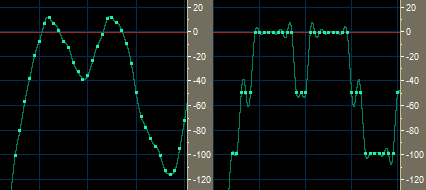Two posts down I mentioned the five musical samples at Is 24-bit Recording Really Better?, from Ethan Winer. Very useful for blind testing, these things, because they each start from the same 24 bit recording, present it in the same 16 bit CD-compatible uncompressed WAV file. The original is presented as — in line with best industry practice — dithered in conversion to 16 bits. It is also presented as truncated to 16 bits (the eight least significant bits are simply omitted), and also truncated to about 13, 11 and 9 bits.

In the latter cases it has been returned to 16 bits resolution for CD compatibility, but the large steps of the lower resolutions have been changed, as shown to the right. This is the same portion of the music from two of the files, closely zoomed in. The scale to the right indicates the decimal value of the samples, each of which is represented as a dot on the wiggly line. The left side is from the 24 bit truncated to 16 bit file, whereas the right side is from the lowest resolution version.
There are some problems with the comparison files which I shall take up with Mr Winer, but for what it’s worth, my own personal tests did not suggest much difference. In particular, playing the files through high fidelity loudspeakers with no processing applied to the signal, I was unable to distinguish any of the files from any of the others. At all.
With high quality headphones, I was able to distinguish what I think is the lowest resolution version. Barely.
